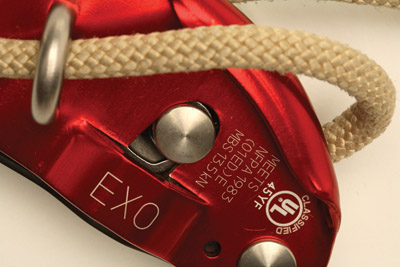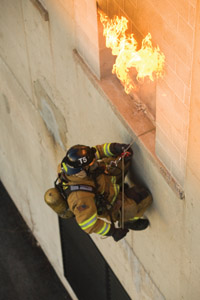
Equipment
Black Sunday
It’s Dec. 2, 2010. The Nassau Veterans Memorial Coliseum in Long Island, N.Y., is filled with fans taking in a hockey game: Rangers versus Islanders. Early in the first period, retired FDNY firefighter Jeff Cool takes a deep breath; he knows the next three hours will be challenging as he tries to get comfortable.
February 28, 2011
By Jay Shaw
It’s Dec. 2, 2010. The Nassau Veterans Memorial Coliseum in Long Island, N.Y., is filled with fans taking in a hockey game: Rangers versus Islanders. Early in the first period, retired FDNY firefighter Jeff Cool takes a deep breath; he knows the next three hours will be challenging as he tries to get comfortable. The two-hour drive into Long Island with his two sons and a fellow firefighter was difficult enough. Shifting in his seat occasionally, Cool tries to find a spot that allows him to focus on the game and his boys. Cool, 43, has met some of his favourite Rangers over the last few years; he’s had some time on his hands since his retirement on Jan. 23, 2005.
Cool didn’t win the lottery or invent some moneymaking formula, and he certainly didn’t go willingly. He was forced out – literally. The event that precipitated his surprise retirement is now known to the fire service as Black Sunday. It’s the only time in the history of the FDNY that two separate incidents caused line-of-duty deaths on the same day; the lives of three firefighters were lost and four other firefighters were severely injured. Cool was one of six FDNY firefighters who were forced to jump more than 12 metres to escape flashover-like fire conditions in a Bronx tenement apartment. Lt. Curtis Meyran and firefighter John Bellew were killed. Firefighter Richard Sclafani was killed in a Brooklyn basement fire the same day. Cool and firefighter Joseph Dibernardo shared a rope that is now credited with helping to save their lives. Dibernardo used his body to anchor Cool, who was able to slide down three or so metres before falling the rest of the way to a concrete landing. Dibernardo tied the rope to a baby gate and tried to get out, but he, too, fell, and lay semi-conscious in the back lane until he was rescued. Rangers are up 2-0 early in the first period. Cool shifts in his seat.
 |
|
| The FDNY worked with Petzl to create a descent-control device similar to one used by climbers following Black Sunday. The system, which includes a descender, a 15-metre heat- and abrasion-resistant rope, a connector, and a steel anchor hook, underwent vigourous testing to ensure it would meet strict performance criteria. Photo courtesy Petzl |
When firefighters are blocked from escape routes, the decision is always going to be to bail. Cool describes those fleeting seconds before he jumped: “You at least have a shot at living if you jump; you just can’t stay in that kind of heat. Joey said, ‘You go, you got a wife and kids,’ and he tried to anchor me with his body. The rope was thin, I slid down a bit, but the heat was exhausting. You can’t hang on.”
Cool does not clearly remember all the details after he hit the concrete. His injuries were so severe he required 13 surgeries. “I broke both my shoulders in multiple places, fractured 13 ribs, fractured my skull in two places, broke L-2 to L-5 in my back. I had a flail chest, compartment syndrome of the abdominal cavity, several burns, but my most severe injury would be shattering my pelvis in three places; it was like broken glass tearing through both my femoral arteries. I was literally bleeding like a stuck pig. As fast as they would pump blood in me, it was coming out. I would take 72 products of blood before all the bleeding was stopped.” Islanders score, but the Rangers still lead 2-1.
The North American fire service has been slowly looking into incorporating firefighter self-rescue devices into comprehensive training programs, as the types of situations that Cool describes are not new. Generally, firefighters stuff their pockets with small tools, wedges, webbing and rope – all items that they have found might be useful when trapped or in a perilous situation. After Black Sunday, the FDNY spent thousands of man hours and countless dollars to test and design a lightweight and easy-to-use system.
The FDNY decided to work with Petzl to create a descent-control device that would meet strict performance specifications defined through a rigorous testing protocol. The Petzl EXO descender is a modified version of a proven belay/rappel device used by climbers around the world for 20 years. This descender, along with a 15 metre heat- and abrasion-resistant rope, a connector, and a steel anchor hook, makes up the FDNY Personal Safety System. The system is attached to each firefighter’s harness via a carry bag, and is available for use at a moment’s notice. With proper training, a firefighter can deploy the EXO system and bail out of an elevated area in as few as 15 seconds.
 |
|
| Petzl’s self-rescue system is attached to each firefighter’s harness via a carry bag, and can be deployed for use in as few as 15 seconds. Photo courtesy Petzl |
Here in Canada, the firefighter self-rescue message has been less aggressively promoted, but is just as needed, as both Winnipeg and Ottawa have had incidents at which these types of devices may have fostered a different outcome. In fact, Ottawa fire Capt. Peter Hunt, who writes for Canadian Firefighter and EMS Quarterly, sang the praises of self-rescue devices in his July 2009 Fire IQ column.
Michel Goulet, Petzl America professional division manager, has been involved with the EXO project since day 1. Goulet and his team of Canadian and American firefighter field experts and training partners have created a train-the-trainer program to ensure proper instruction is provided before the system is issued to fire departments. Goulet and his team ran a three-day program in Winnipeg.
Winnipeg Fire Paramedic Service is the first large Canadian department to implement the EXO personal escape system in its firefighter self-rescue program.
“As experts in rope access and vertical rescue, Petzl has become aware of the need for bailout systems to be carried by firefighters who respond to emergencies in multi-level dwellings,” says Goulet. “The EXO system provides a firefighter with a rapid means of escape through unconventional exit points; it has already proven itself as a viable solution, both in firefighting and military applications.”
No one will argue the need to make interior fire fighting safer, as all too often, a rapidly changing fire event ends with a hospital visit.
The Islanders are up 3-2 and Cool’s mind is completely immersed in the hockey game. For the next two periods, he escapes; finally, no pain, no nightmares. Cheering and screaming for Sean Avery and his beloved Rangers with his sons, Jeff and Dylan, Cool feels alive and empowered.
“Today, I am basically a stay-at-home dad who enjoys spending my time with my family,” he says. “I love coaching hockey and enjoy the smell of the rink as much as I enjoyed the smell of a good fire. I just don’t want this to happen to anyone else, ever. We spend thousands of dollars sending firefighters into burning buildings to save life and property. Why can’t we spend a few more bucks on a personal safety system for a firefighter, so when and if he becomes trapped, he is not faced with, ‘Do I jump and hope for the best, or do I stay here and die in the fire?’ ”
Cool occasionally lectures across the United States about Black Sunday and the need for personal safety systems. He still requires counselling and therapy and will never truly be the same. But tonight he’s just one of the guys – a husband, father, firefighter and hockey fan. Rangers win, 6-5.
Jay Shaw is a nine-year member of the Winnipeg Fire Paramedic Service and has more than 15 years of experience in health and emergency services. Shaw has worked in hospital emergency rooms, rural ambulance services and with the Canadian Forces fire service. A lifelong learner, Shaw is completing graduate studies in disaster and emergency management at Royal Roads University and has a strong passion for collaborative disaster and fire service research. Contact him at jjrg@mts.net
Print this page